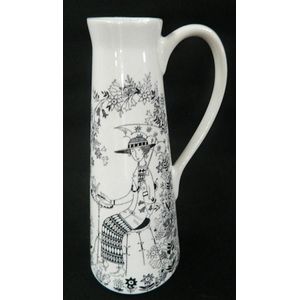Royal Worcester Floral Pitcher Vase
You must be a subscriber, and be logged in to view price and dealer details.
Subscribe Now to view actual auction price for this item
When you subscribe, you have the option of setting the currency in which to display prices to $Au, $US, $NZ or Stg.
- Ivory - Ivory is a hard white material that comes from the tusks of elephants, mammoth, walrus and boar, or from the teeth of hippopotamus and whales. The ivory from the African elephant is the most prized source of ivory. Although the mammoth is extinct, tusks are still being unearthed in Russia and offered for sale.
Ivory has been used since the earliest times as a material for sculpture of small items, both in Europe and the east, principally China and Japan.
In Asia ivory has been carved for netsuke, seals, okimono, card cases, fan supports, animals and other figures and even as carved tusks.
In the last 200 years in Europe ivory has been used to carve figures, for elaborate tankards, snuff boxes, cane handles, embroidery and sewing accessories, in jewellery and as inlay on furniture. Its more practical uses include being used for billiard balls, buttons, and a veneers on the top of piano keys.
The use and trade of elephant ivory have become controversial because they have contributed to Due to the decline in elephant populations because of the trade in ivory, the Asian elephant was placed on Appendix One of the Convention on International Trade in Endangered Species (CITES), in 1975, and in January 1990, the African elephant was similarly listed. Under Appendix One, international trade in Asian or African elephant ivory between member countries is forbidden. Unlike trade in elephant tusks, trade in mammoth tusks is legal.
Since the invention of plastics, there have been many attempts to create an artificial ivory - Ewer / Pitcher - A type of jug with a narrow neck bulbous body and wide spout, originally used for carrying and storing liquids such as water or wine. In medieval times they were the source of water to wash ones hands during and after a meal. later the shape was used for vessels in silver, gold, glass and ceramics.
In Victorian times they were made in ceramics and occasionally glass with a matching basin, and sometimes other accessories such as a soap holder or toothbrush holder. Their purpose was to provide facilities for personal washing In the early 19th century were often enclosed in purpose built stands, and later resided on a washstand..
Sometimes the words "ewer" and "pitcher" are used interchangably, but a pitcher is generally considered to be a jug, and would have a wide mouth, and a gently tapering body. - Husk Motif - The husk motif is a decorative element that has been used in furniture, silver, glass and ceramics decoration for centuries. The motif is typically based on the shape of the husk, or outer covering, of a nut or seed. It is often depicted as a series of overlapping, scalloped shells that create a textured, ornamental pattern.
In furniture, the husk motif is commonly used in the design of chair and table legs, as well as in the decoration of cabinet doors and drawer fronts. The motif is carved into the wood or other material, creating a three-dimensional effect that adds depth and visual interest to the piece.
In ceramics, the husk motif is used in a variety of ways, from the decoration of bowls and plates to the design of decorative tiles and other objects. The motif is often painted or carved into the surface of the clay, creating a relief pattern that adds texture and dimensionality to the piece.
The husk motif has been used in many different historical and cultural contexts, from ancient Greece and Rome to 18th-century France and England. It has been adapted and modified over time, with variations including the acanthus leaf and the palmette motif.
This item has been included into following indexes:
-
Royal Worcester (England), item types
- jugs & ewers 349
- other 3,563
- vases, other 1,206
Visually similar items

Spode 1973 commemorative loving cup, 16 cm high

Royal Worcester porcelain jug of cylindrical form, decorated with sprays of flowers, in tones of red, blue, yellow and green on ivory coloured ground, a/f, height 16.5 cm

An Arabia jug black and white decoration depicting tea in the park. Height 21 cm

A small Japanese silver cream jug with relief shippo enamel wisteria flower in green, blue and mauve. Kanji stamped. C.1900. Height 7 cm
